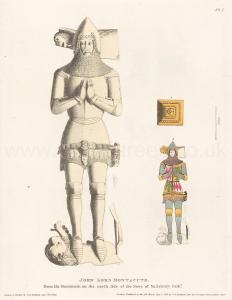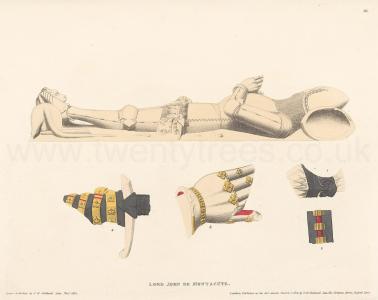Effigy of John de Montacute
Effigy of John de Montacute is in Monumental Effigies of Great Britain.
SIR JoHN DE MoNTACUTE, or Montagu, (Mons acutus and Mont aigu are synonymous appellatives,) was the son of William first Earl of Salisbury, to which title his elder brother William (age 61) succeeded. He served in the wars in France under Edward the Third, and was at the battle of Crecy in 1346. In 1372 he is mentioned as in the King's fleet at sea in the retinue of his brother the Earl of Salisbury. He was present in the expedition into Scotland undertaken by Richard the Second (age 22), A. D. 1385. He was then a Knight Banneret, and was retained to serve the King in person, attended by another banneret, five knights, and their esquires, sixty men-at-arms, and sixty archers. As Steward of the King's Household, he was sent to conduct into England Ann of Bohemia (age 23), with whom Richard the Second (age 22) had contracted marriage. He married Margaret, daughter and inheretrix of Thomas de Monthermer, in whose right he held divers lordships and manors, and was summoned to Parliament as a Baron of the Realm from the 31st of Edward III. to the 13th Richard II. 1389, in which year he died. His will was dated the 20th March, 1388, and directed that he should he buried in the cathedral church of Salisbury [Map], between two pillars, or, in case he should die in London, in the cathedral church of St. Paul, where he was baptized. He ordered that a black woollen cloth should be laid over his body, covering it and the hearse on which it rested, the ground underneath to be spread with cloth of russet and white, of which every poor man attending his funeral should have enough to make himself a coat and a hood. That on the day of his funeral the lights should consist of hve tapers, each weighing twenty pounds, four mortaries, each of ten pounds weight, and twenty-four torches, to be borne by as many poor men in russet and white. That the emblazonments about his herse should consist only of one banner of the arms of England, two of the arms of Montacutea, and two of Monthermer; by the last the hve tapers were to be placedb. That there should be a plain tomb made for him, with the image of a knight thereon, bearing the arms of Montagu, or Montacute, and having a helmet under his head. He was interred in the Lady Chapel of Salisbury Cathedral [Map], and his tomb still remaining shows that the directions of his will were pretty closely followed. Under his head is his helmet, having a griffin for crest. His surcoat quarters. Argent, three lozenges in fess Gules, for Montacute; Or, an eagle displayed Vert, for Monthermer.



Details. Plate I. 1. Ornament on the girdle. 2. Figure as originally painted. Plate II. Profile. 1. Part of the wing of the grifhn, &c. 2. Lace of the caniail, passing through loops on the basinet. 3. Gauntlet enlarged. 4. Hilt and part of the scabbard of the sword, round which is twisted the belt.
Note a. The shield of Montacute may to this day be observed on a buttress of one of the buildings in the Court of Carisbrooke Castle [Map], Isle of Wight. The gateway, and many other parts of that fortress, are evidently of the time of Richard the Second, and William Montacute, Earl of Salisbury, in the 9th of that King's reign, had a grant of the Isle of Wight, Carisbrook Castle, and the royalties on them dependent.
Note b. Of the disposition of these tapers and mortars, or mortuary lights, at funeral solemnities, an excellent idea will be acquired from the print of the funeral of Abbot Islip, published by the Society of Antiquaries, in their Vetusta Monumenta.

